Concepts
Uber, Etsy and the internet of everybody: A visual guide to networked businesses
This post is part of an ongoing series on the fundamentals of Platform Thinking.
The natural purpose of a network is to connect. Fax machines, telephone networks, stock exchanges and credit card networks have done exactly that. With the internet, we now have a universal network that connects everyone with everyone (well, almost).
When we think of social networks and marketplaces, these are again businesses that create networks on top of the internet ‘network’.
Networks inherently bring in a unique challenge. When things move in a straight line (as is the case with Pipes), there is only one direction in which they can move. On a network, however, anything can move in any direction. Networks function well when the right thing is transferred to the right destination. Imagine FedEx delivering the wrong package to your house.
How Networks Work
I’m going to draw on a basic concept from network theory for this post.
FedEx works like a network; it delivers packets from a source to a destination. If it gets its act wrong, an elderly couple in the Mid-West may end up with a stripper’s pole on their doorstep. So here’s how FedEx gets it right most of the times (and I’m again oversimplifying for illustration):
- It gathers data from the sender (source) about the recipient (destination) (Address etc.)
- It converts this data into some internal code to give routing instructions to everyone involved in the transfer
- It delivers the package
Routing, a concept from network theory, is the process of selecting the best path on a network.
Every time you type a URL in your browser and hit enter, packets of data start traveling on the network and need to be routed. To get to the right destination, much like FedEx, these packets carry some routing information which is read along the way to make routing decisions for the packet.
There are two key aspects of computer networks:
- Packets move around
- Packets carry some information that enables the network to send them to the right destination
The goal of the network is to transfer the packet from the source to the destination with minimum failure.
False positives deliver packets on the wrong doorstep. False negatives prevent the right recipients from receiving the packet.
How Platforms use Routing in Business Design
Let’s leave the world of computer networks and get back to our familiar world of internet platforms. Most platforms work in similar ways.
Every platform is responsible for the transfer of packets from source to destination. This is what I refer to as the Core Value Unit, in the previous post.
Twitter transfers Tweets from tweet creators to tweet readers.
YouTube transfers Videos from Video creators to Video viewers.
LinkedIn transfers Jobs from Recruiters to Professionals.
Airbnb transfers Apartment listings from Hosts to Travelers.
Uber transfers a Cab request from a Traveler to a Cabbie.
All of these platforms rely on the ability to correctly transfer the Core Value Unit from the source to the destination.
Irrespective of what these platforms do, the success or failure of their business model is dependent on their success or failure at making this transfer happen.
Hence, on a platform,
- Value Units, like packets, move around
- Value Units carry some information that enables the platform to send them to the right destination
A visual guide to connected businesses
But businesses are not just about the transfer of data packets and information. They require the transfer of all three: stuff, money and information.
Pattern 1: Information + Money
For Uber to work as a business, three transfers are involved:
- Transfer of booking information from Traveler(Consumer) to Cabbie(Producer)
- Transfer of transportation-as-a-service from Cabbie(Producer) to Traveler(Consumer)
- Transfer of money from Traveler(Consumer) to Cabbie(Producer)
If we were to illustrate these flows for Uber, this is what it would look like:
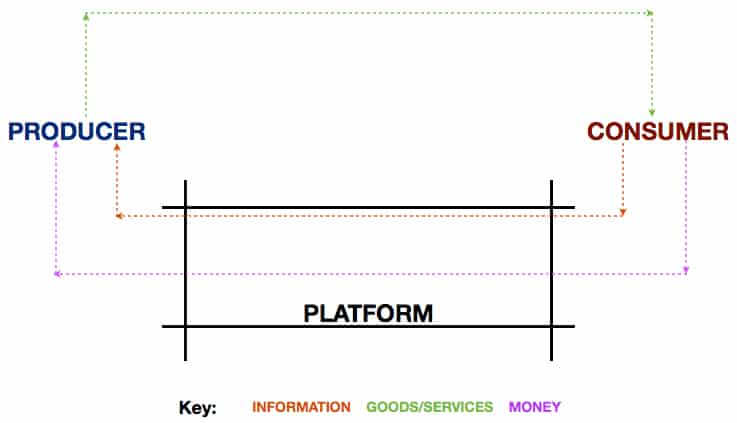
TaskRabbit follows a similar pattern where information and money flow through the platform but services flow external to the platform.
This illustrates two important points about platform businesses, which we will look into further:
- All platform businesses require the transfer of information, stuff (goods/services) and money
- Some or all of these transfers may occur on the platform
- The information transfer ALWAYS occurs ON the platform. The transfer of stuff and money may or may not occur on it.
- All other transfers get kick-started because of the information transfer
Let’s look at a variant of this model: Etsy.
For Etsy to work as a business, we need:
- Transfer of listing information from Seller(Producer) to Buyer(Consumer)
- Transfer of money from Buyer(Consumer) to Seller(Producer)
- Transfer of physical goods from Seller (Producer) to Buyer (Consumer)
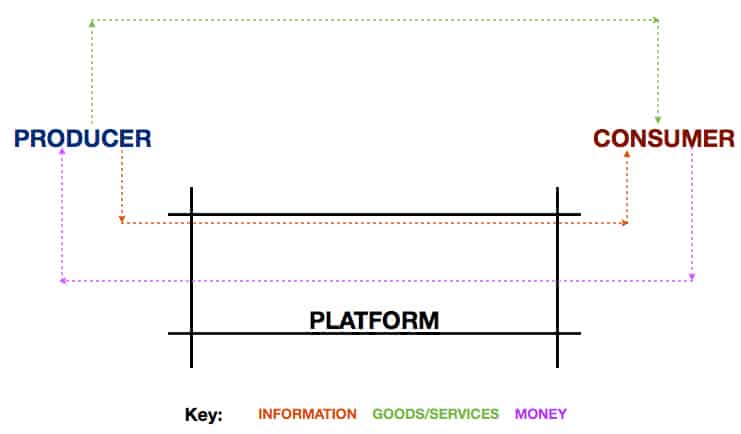
In this case, again, the transfer of stuff occurs external to the platform while the transfer of money is captured on the platform.
In all these cases where the transfer of money occurs internal to the platform, platforms often take a transaction cut.
Pattern 2: Information only
There are many platforms where the transfer of money occurs external to the platform. In such cases, platforms usually monetize by charging a premium listing fee or a lead generation fee. Unlike a transaction cut, these fees are not contingent on the platform’s ability to create value by facilitating all three transfers.
Let’s look at Craigslist, as an example of a platform with money exchange occurring outside it.
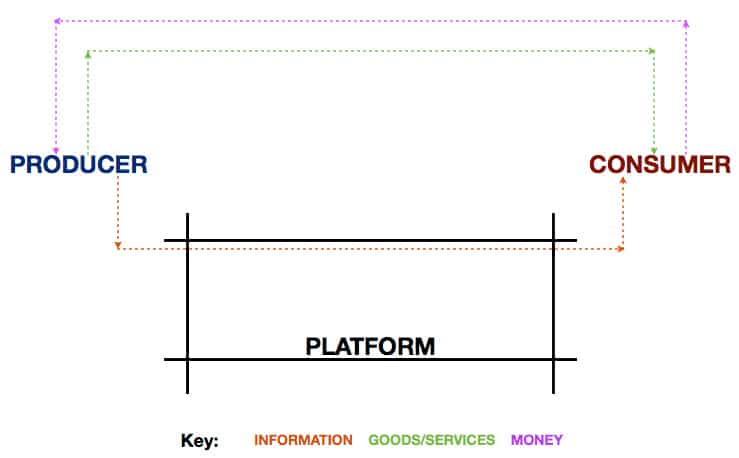
Platforms like Yelp and Justdial have the money transfer between the participants occurring outside the platform. As a result, they rely on subscription or lead generation fees.
Groupon, on the other hand, sees money transfer occurring both on the platform (upto the value of the deal) as well as off the platform (if the transaction exceeds the value of the deal).
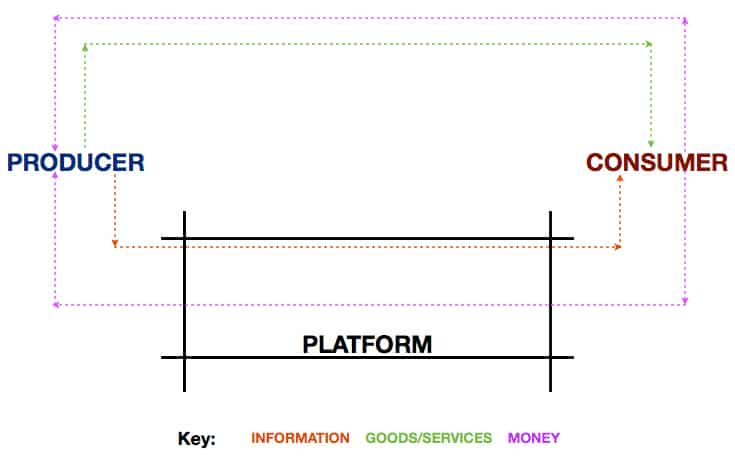
Pattern 3: Information + Stuff + Money
So far, we’ve looked at patterns where the stuff transfer is external to the platform. However, there are many cases in which stuff transfer is internal to the platform.
Obviously, given the digital nature of internet-enabled platforms, this applies to virtual goods (including content) and to services which can be delivered and tracked digitally.
Let’s look at the services example. Clarity and Upwork are examples of such a pattern where the service is performed ON the platform. For Clarity, this is how the model works:
- Transfer of a call request from Requestor(Consumer) to Expert(Producer)
- Transfer of services from Expert(Producer) to Requestor(Consumer) via call
- Transfer of money from Requestor(Consumer) to Expert(Producer)
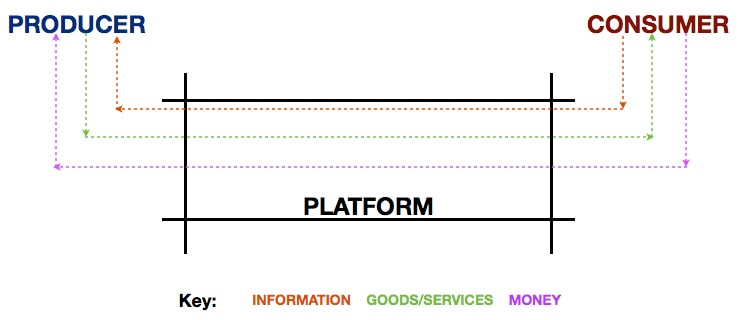
We see a similar model work out with virtual goods. Take the Kindle Store as an example. It facilitates the transaction in the following way:
- Transfer of information from e-book author (Producer) to e-book searcher (Consumer)
- Transfer of money from e-book searcher (Consumer) to e-book author (Producer)
- Transfer of e-book from e-book author (Producer) to e-book searcher (Consumer)
Of course, this is understating the intermediary role played by the platform, but that is only done for ease of illustration.
This is how this looks:
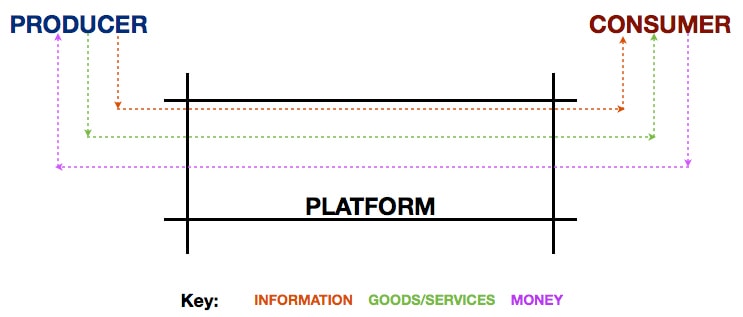
All platform businesses require the transfer of information, stuff (goods/services) and money/attention/reputation.
Feel Free to Share
Download
Download Our Insights Pack!
- Get more insights into how companies apply platform strategies
- Get early access to implementation criteria
- Get the latest on macro trends and practical frameworks
Pattern 4: (Information-Stuff) + Money
This becomes more complicated in the case of online content. Content is a virtual good as well but, unlike an e-book, the listing and the goods are not distinct. The information and the goods are often one and the same. A blog post, for example, is content, but all the information that Google uses to ‘transfer’ it to someone searching for a related topic is extracted from the content. To be fair, this is where the distinction between content and metadata comes in. A video on YouTube or a blog post on Medium has both content and metadata. The content is the good/stuff while the metadata is the information that helps it get delivered to the right destinations. But for most practical purposes, the content and the metadata move together in such cases and are collectively the value unit.
Pattern 5: Non-money
Finally, not all interactions involve the exchange of money between participants. If you think of Facebook or YouTube, there is an interaction between content creator and content consumer (remember, the same person may perform different roles in different interactions) and a separate interaction between content consumer and advertiser. The first one doesn’t involve the transfer of money, the second one does.
In the first interaction, there is transfer of attention instead.
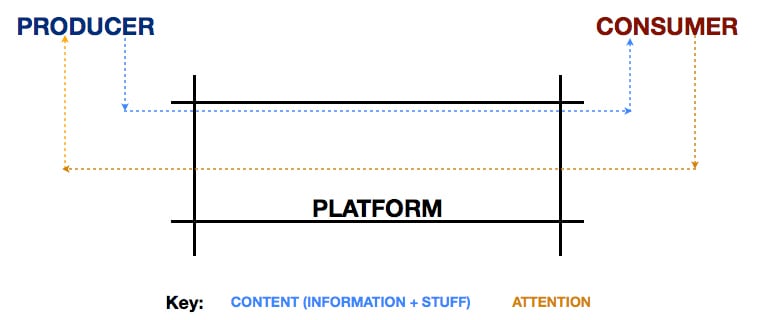
Another variation of this is a pattern where there is transfer of reputation. We’ll look into these in detail in subsequent posts.
So What?
Here’s the key commonality across patterns. Any interaction and exchange on a platform ALWAYS starts with a transfer of information. The transfer of information is responsible for:
- Connecting supply and demand
- Enabling the two sides to make a decision on exchanging stuff, money or attention/reputation.
There are other nuances we will explore further in subsequent posts:
- In most cases, the transfer of information is from producer to consumer
- In case of services, the transfer of information may be from consumer to producer
This is why all platforms are information-enabled businesses. The business is broken without the transfer of information to connect supply and demand and spark the interaction. This is the reason why the Core Value Unit is so important. Because the Core Value Unit is the unit that carries this information around on the platform and allows the Producer and the Consumer to interact.
Summary
In summary, let’s recap the points I stated upfront:
- All platform businesses require the transfer of information, stuff (goods/services) and money/attention/reputation.
- Some or all of these transfers may occur on the platform. The platform’s monetization options are dictated by which of these transfers can be captured on the platform.
- The information transfer ALWAYS occurs ON the platform. The transfer of stuff and money may or may not occur on it.
- All other transfers get kick-started because of the information transfer.
Finally, what bears keeping in mind, once again, is the fact that the primary purpose of a network is transfer. Transportation networks transfer goods; computer networks transfer data packets. And in a similar fashion, any network-enabled business model (platform) creates value by correctly transferring value units. YouTube transfers videos, Uber transfers cab requests and so on. When transfer occurs correctly, the right producer and consumer get matched with each other and the transaction happens. This matching of supply and demand, through the core value unit, is the key value that a networked platform creates.
To read the rest of the posts in this series, click here.
State of the Platform Revolution
The State of the Platform Revolution report covers the key themes in the platform economy in the aftermath of the Covid-19 pandemic.
This annual report, based on Sangeet’s international best-selling book Platform Revolution, highlights the key themes shaping the future of value creation and power structures in the platform economy.
Themes covered in this report have been presented at multiple Fortune 500 board meetings, C-level conclaves, international summits, and policy roundtables.
Subscribe to Our Newsletter













